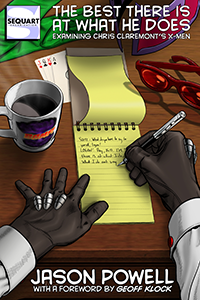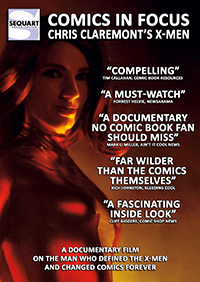The first major crossover of my time as devotee of the Uncanny X-Men, Inferno marked the culmination of year’s worth of story, a vast majority of which I was unfamiliar with at the time, and which also encompassed a great deal more than just the characters featured in UXM. It was a tale that not only incorporated the members of the New Mutants and X-Factor teams, but also spilt over into the larger Marvel Universe with books such as Daredevil and Amazing Spider-Man.
The heart of the story though was laced through UXM, X-Factor, and New Mutants with the first two intimately tied to one another while the third’s arc took place parallel to the events of the others. Still, in the same manner which the assorted tie-ins books to modern events like Original Sin or Forever Evil are impacted by one another, so too did the events of one influence the other.
For the purposes of this overview though, and keeping in the vein of the UXM-centric nature of this series, my focus will fall with the Uncanny X-Men issues (#240-243) as well as the X-Factor ones (#37-39) that tell their own unified story.
Writers: Chris Claremont (X-Men), Louise Simonson (X-Factor)
Pencilers: Marc Silvestri (X-Men), Walter Simonson (X-Factor)
Inkers: Dan Green/Hilary Barta (X-Men), Al Milgrom (X-Factor)
Colorists: Glynis Oliver (X-Men), Tom Vincent (X-Factor)
Letters: Tom Orzechowski (X-Men), Joe Rosen (X-Factor)
Editor: Bob Harras
UNCANNY X-MEN #240
Although the setting can no doubt be called a cliché in the medium of comics, the crux of this story takes place in New York City where, as we began to see in the prelude, a transformation is taking place. With the proper kick-off to the event in UXM #240, we see the first physical indicator of this change to the city as Madelyne Pryor (in Goblin Queen garb for one panel before changing back into a little black dress for Havok) observes a spire on type of the Empire State building and its appearance is noticeably demonic. It’s not the only transformation in this initial sequence, we also see an elevator consuming a quartet of Ghostbuster-esque scientists and turning them into a mural, but it is the beginning of what is one of the central themes of the Inferno event.
Maddie’s trip down memory lane as she stands before the grave of Jean Grey brings to light another of the themes prevalent in Inferno: betrayal. For her, initially, it is about the Cyclops’ betrayal of his marriage vows and abandonment of his family to Jean but the betrayal through-line, just as the transformation one, comes to mean so much more as the story develops.
Now from the writer’s perspective, given how much time Chris Claremont had spent growing Cyclops in his time with the character, the fact that he was essentially forced into giving him up for the X-Factor launch in such a fashion must have been difficult. It was a decision antithetical to the core of Cyclops’ character, one very difficult to rectify with the loyal and dutiful man Claremont had written all that time, and in territory explored in the X-Factor book it was also something that Jean herself had trouble accepting from the man she knew prior to her “death.” Whether by coincidence or through intention, that theme of identity (and loss thereof) also proves a crucial one to the larger Inferno story. In this first part alone, Madelyne turns Jean Grey’s parents into demons (“…reduced to their demonic essence,” she says) which essentially strips them of their identity while Rogue, Dazzler, and Longshot have it out over his identity in each woman’s life (friend vs. boyfriend). All the while Rogue (wearing Dazzler’s clothes it must be noted) is basically trying on Allison Blaire’s identity.
Madelyne’s own identity comes into question when N’astirh leads her into Sinister’s lair (the Nebraska orphanage in which Cyclops was raised) that we saw in the Prelude only for her to find a crèche reminiscent of that in Genosha. As she did in the cemetery, Maddie’s powers seem to pull out memories and give them substance thus projecting an image of a woman who looks like her into the crèche that is labeled “Replicant Research” with a “Madelyne” ID tag on it.
The very identity of the X-Men also falls into question with this first chapter as their hunt for the Marauders, Sinister’s soldiers responsible for the Mutant Massacre in the Morlock tunnels, are discovered hiding out in those tunnels. Our mutant heroes elect to take the fight to them in order to “pay them back in kind” as Storm puts it and the precision with which the X-Men strike, coupled with the ferocity of the attack, leads one member of the Marauders to note that “they’re out for blood.” One of the team’s own members, Havok, even questions their identity in comparison to the killers that compromise the Marauders numbers.
The X-Men decimate them with relative ease with Claremont even working in one of his own personal tropes as Colossus ends up being magnetically manipulated by Polaris/Malice. In the midst of a Mexican standoff with Storm, Malice tosses Piotr through the tunnel ceiling and onto the streets of NYC above where the two groups find a city changed. In that moment, Madelyne also finds her life changed forever as Mr. Sinister introduces himself as her “Father,” drastically increasing his importance to the larger X-Men story and in just one panel.
UNCANNY X-MEN #241
Manipulation and identity, transformation and origins; those all come into play as the story continues to unfold on two stages. The first is the ongoing battle between the X-Men and the Marauders on the streets of a rapidly changing New York City. The second takes place in the Nebraska orphanage between Madelyne and Sinister with N’astirh lurking in the shadows.
With the big battle, we immediately see the transformations to NYC in the background buildings and in the humorous, but insane, visuals of a mailbox eating a man’s hand while yelling “insufficient postage” and in a living fire hydrant beating a dog as it scolds the poor pup. These rather superficial transformations are not the only bits of madness enveloping the Big Apple though, as Colossus is confronted with Riptide, the Marauder he killed during the Massacre, inexplicably reborn, while simultaneously dealing with the police. (Their cars have also transformed into monstrosities.)
One note on Riptide, this rebirth of his, along with the inclusion of Savage Land mutate Vertigo in the Marauders, are two things never addressed by Claremont during his tenure with the book. Eventually, years later and likely from Scott Lobdell or Fabian Nicieza, we learn that Sinister has a clone bank of all the Marauders (in addition to nearly every other person on Earth) thus retroactively explaining Riptide’s presence here. Sinister’s clone farm would also provide a convenient way for writers to recycle, ad nausem, a villain whenever they were killed off by others. As for Vertigo, this iteration may either be the original or a clone, but either way it is never addressed anywhere how she ended up with Sinister from the Savage Land.
Regardless of the “how,” her presence in the Marauders provides a tie to the history of the X-Men even if, in Vertigo’s specific case, it isn’t any members of this particular iteration. The same can be said for Polaris’s inclusion in Sinister’s unit in regards to Havok, retroactively for Sabretooth’s involvement (as his history with Wolverine had only barely been touched at this point in UXM #213), and now with Riptide and Colossus’ connection.
Back to the fight itself, the transformation and identity motifs are kicked up several notches as the X-Men themselves (Colossus excluded) physically begin to change to reflect the demonic influences on New York City. Wolverine, for example, grows more animalistic with protruding fangs and even the points of his mask becoming horn-like in appearance while his teammates begin to revel in the violence and destruction their fight with the Marauders has brought. Rogue and Storm, in a moment far from the core of the characters, actually high-five one another in celebration of their victory over Sinister’s mercenaries! Psylocke’s face is lost in the shadow of her costume’s hood, Dazzler becomes obsessed with her appearance, and poor Longshot, already questioning himself because of the Rogue/Dazzler dynamic, is torn down further by N’astirh. The X-Men’s very identities have been lost to the Inferno.
As for Madelyne, her encounter with Sinister proves the catalyst for all of the horrors that follow as he rips out any shred of identity Maddie thought she had and exposes it as a falsehood. This is her “father” (Chris Claremont) sitting her/the reader down and telling her/us everything she/we ever thought she/we knew about her was wrong. Maddie’s oldest memory is actually of the moment Jean Grey’s powers manifested while her body is nothing more than a clone of Jean’s since Xavier got to Ms. Grey before Sinister was able. Maddie’s “birth” was tied to the death of Phoenix on the Moon and even her presence in Cyclops’ life was puppeteered by Sinister to create an exceptional offspring, Sinister figuring Maddie’s physical appearance alone would be enough to pique Scott’s interest and then, as he states, “…nature would take its inevitable course”.
Presumably, Sinister thought this deconstruction of Madelyne’s identity would destroy her and leave her at his mercies. It is a train of thought completely understandable. Imagine being in those shoes and finding out nothing you thought you knew about yourself was genuine. It would be akin to finding out you’re adopted after living for years under the belief that you knew your parents. It could potentially be world destroying and certainly world altering at least. Now take what could be a response in the real world and amp it up a thousand-fold for a comic book reality in which the person has eldritch powers far beyond what her creator ever anticipated. Where Sinister expected to break his creation (and that is all he saw her as) to his will/purpose instead he strengthened her and broke her in a fashion he never anticipated. Madelyne’s final words to her “Father,” as N’astirh hands her her son, of making dust of all his machinations is the real end result of Sinister’s plans. Her loss of identity is total. Her son is now nothing more than a tool and Maddie’s declaration of abjuring life and giving herself to the fire tells her “father,” and the reader, just how completely she has fallen. Sinister has, in essence, freed Madelyne Pryor from her humanity and helped give birth to a Goblin Queen unfettered complete with Nathan Christopher Charles Summers back in her arms.
An aside before the wrap-up: this issue also represents the fashion in which the events of other Inferno books influenced aspects of UXM’s story. First there is the disappearance of Colossus mid-story so he can wander off into New Mutants #73 to help his sister Illyana/Magik/Darkchilde in her battles with S’ym. Then, at the close of UXM #241, N’astirh’s red appearance instead of his usual green (as he was earlier in the same issue) is reflective of the events in X-Terminators #4 and New Mutants#72 where he battle S’ym and took in the Transmode Virus. They are small things at this point, a panel here and there, but they remind the reader that this event has ramifications outside of the book they are currently reading. It may only be a minor touch here and there, but it puts context to the events relative to one another which is something I feel is lacking in today’s comics world in which multiple characters appear in multiple books simultaneously in depictions that don’t necessarily sync with one another (see Wolverine’s general usage for an easy example).
Next: The X-Men and X-Factor meet.






















































